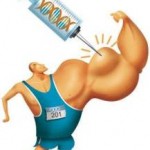Athletes are competitive by nature, and many will do whatever they can to win. Steroid usage is heavily monitored in competitions, yet with the coming of the Winter Olympics, whispers of “gene doping” are becoming audible. There has been a craze by athletes for “gene juice” ever since a 2005 study performed by Dr. Ronald Evans, a geneticist at the Salk Institute for Biological Studies in San Diego, California, produced the “Marathon Mouse”. Evans discovered a gene involved in muscle formation and altered it, producing a mouse that could run twice as far as normal mice. This spurred the World Anti-Doping Agency (WADA) to list gene doping as illegal.
Evans was searching for a way to treat muscular dystrophy, characterized by muscle wasting and inability to build muscle. His study was based on the idea of gene therapy: treating a disease caused by a mutated or malfunctioning gene by inserting copies of the normal gene into cells. The cells essentially replace the non-functional gene with the normal one. So, if you can use gene therapy to treat mutated genes, why can’t you use gene therapy to replace a “normal” athletic gene with a “high performance” athletic gene?
A review article by Dr. Craig Sharp that will be published in March, 2010, titled “The Human Genome and Sport, Including Epigenetics, Gene Doping, and Athleticogenomics,” discusses many athletic performance gene discoveries that may be possible targets for gene doping. One example is a gene encoding myostatin, an inhibitor of muscle growth. Exercise tears muscles, which results in increased expression of actin and myosin. This increase in expression is eventually repressed by the protein myostatin, preventing excessive muscle growth. In 2004, a boy was born with a mutated form of myostatin that disrupted some of the protein’s function. The boy had significantly hypertrophied muscles, and was still unusually muscular at age 4. Based on studies like this one, by injecting muscle cells with the mutated form of myostatin, Sharp believes that athletes and bodybuilders can create greater muscle mass than without the gene doping because inhibition of muscle production will be decreased following exercise. Who knew genetic studies could lead to Schwarzenegger-sized people?
Death does not seem to scare overzealous coaches and athletes, who may bypass the risks of gene doping to achieve that extra edge. In several gene therapy studies, some patients developed cancers or severe autoimmune responses to the product of the injected genes. A 2008 report by Dr. E.B. Wheeldon showed that a patient went into an extreme immune response due to a reaction with a carrier virus used to transmit the gene of interest into his cells, causing death from organ failure. This does not seem to discourage some athletes and coaches.
Have athletes started using gene doping to get ahead? An experimental drug, Repoxygen, was developed to treat severe anemia due to a mutated gene. As several Olympic coaches discovered, Repoxygen contained the gene for erythropoietin (EPO), which increases red blood cell production and performance. EPO itself is a currently banned substance by WADA for performance enhancement—but how can one detect the gene for it? There are no current established methods for gene doping detection aside from muscle biopsy, says Sharp, which is a painful and unappealing method of detecting changes in tissue development. A rising technique commonly used in cancer genomics may be the key: DNA microarray. A DNA microarray detects changes in gene expression in a person between two periods in time. In order for anti-doping agencies to use this method in top competitions such as the Olympics, an athlete’s genetic file must be established as a reference. WADA has already developed a “passport” program to keep blood and urine samples of athletes on file to use for future genomic comparisons.
Gene doping raises an ethical issue that surpasses steroid use due to its difficulty in detection, although gene doping has been banned for over 5 years for major competitions. By the 2012 Summer Olympics in London, genetic testing could be a common procedure by anti-doping committees. It seems that as we learn more about the way the body responds to exercise and why the world’s top athletes are so good, more daemons are unleashed from Pandora’s box.
